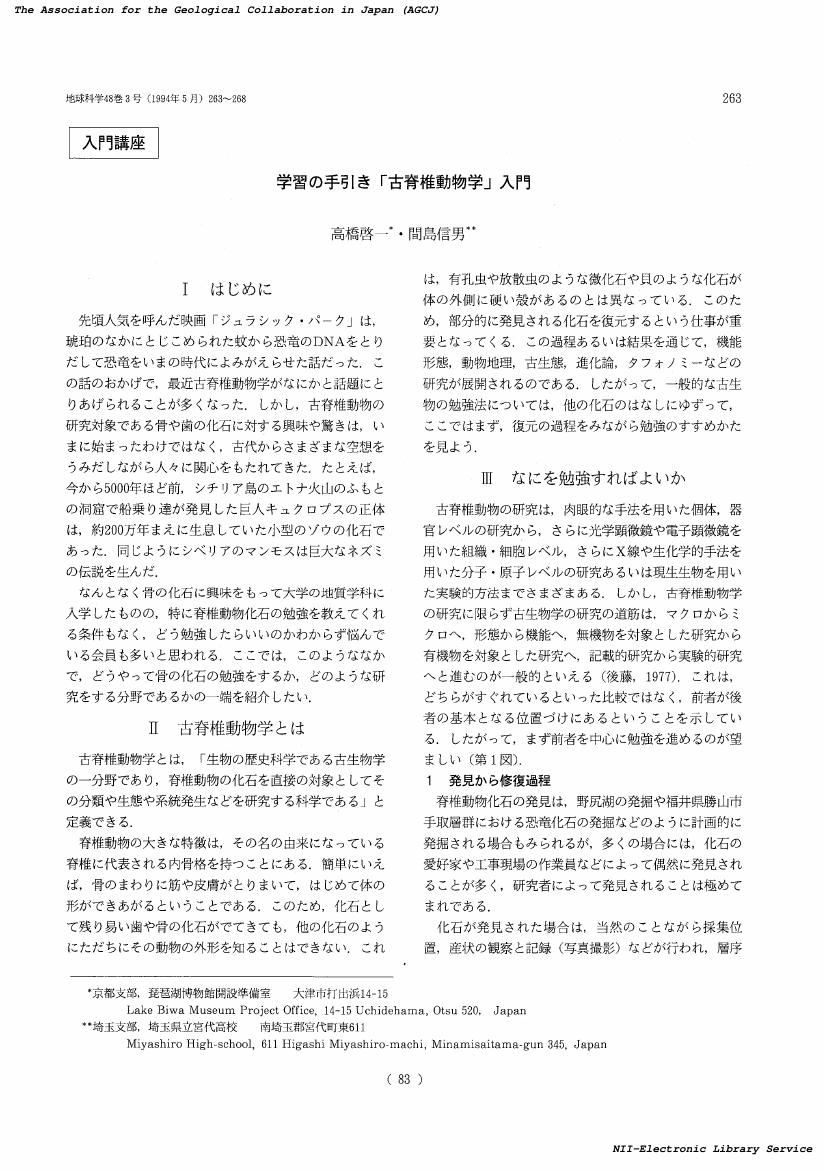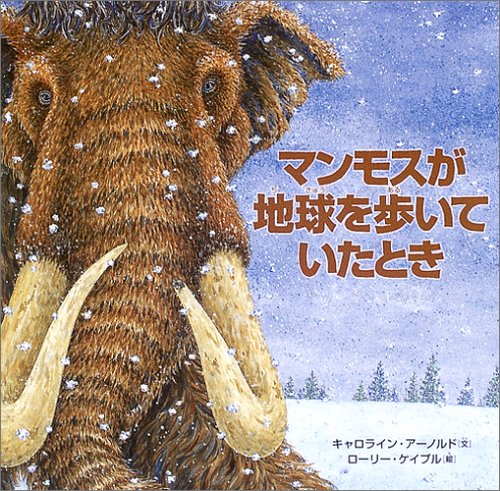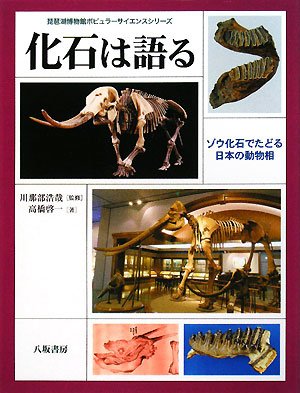12 0 0 0 OA ナウマンゾウ研究百年
- 著者
- 高橋 啓一
- 出版者
- 滋賀県立琵琶湖博物館
- 雑誌
- 琵琶湖博物館研究調査報告 (ISSN:2436665X)
- 巻号頁・発行日
- vol.35, pp.1-253, 2022 (Released:2022-12-22)
I. History of studies 1. Dawn of research 2. Development (2.1 Progress of phylogenetic studies,2.2 Development of stratigraphic studies, 2.3 Studies of morphological reconstructions) 3. Period of new studies (3.1 Phylogenetic problems, 3.2 Mutations, 3.3 Chronology and distribution) II. Localities 1. On the previous and updated locality list 2. Updated locality list (2.1 Hokkaido and Tohoku regions, 2.2 Kanto region, 2.3 Chubu region, 2.4 Kinki, Chugoku, Shikoku and Kyusyu regions) III. Stratigraphic distribution 1. Study history 2. Age of first appearance 3. Formation of the Kanto Plain and sediments including P. naumanni (3.1 Transition of the plain and sedimentary environment, 3.2 Sedimentary facies and mode of occurrence of P. naumanni on the Boso Peninsula, 3.3 Occurrence in Tokyo) 4. Age of extinction and causes (4.1 Age of extinction, 4.2 Causes of extinction) IV. Morphology 1. Morphology of each part (1.1 Cranium, 1.1.1 Terminology, 1.1.2 Characteristics, 1.1.3 Sex dimorphism 1.2 Mandible, 1.3 Tusks, 1.4 Molars, 1.4.1 Characteristics of the genus, 1.4.2 species characteristics of the species, 1.4.3 Characteristics of upper and lower molars,1.4.4 Differences of tooth type, 1.4.5 Variation of molars n regional populations,1.4.6 Morphological changes due to occlusal wear and age assessment, 1.4.7 Sex dimorphism in molars,1.4.8 Pathological morphology, 1.4.9 Histological and biochemical studies, 1.5Hyoid bones, 1.5.1 Morphology of the stylohyoid, 1.5.2 Features and variation of the stylohyoid, 1.6 Axial skeleton, 1.6.1 Spinal column and vertebrae, 1.6.2 Ribs, 1.7 Limbs, 1.7.1Scapula, 1.7.2 Humerus, 1.7.3 Ulna, 1.7.4 Radius, 1.7.5 Forefoot bones (carpus metacarpus, phalanges), 1.7.6 Innominate bone, 1.7.7 Femur,1.7.8 Patella, 1.7.9 Tibia, 1.7.10 Fibula, 1.7.11 Hind foot bones (tarsus, metatarsus, phalanges) 2. Reconstructions (2.1 Skeletal reconstructions, 2.2 Biological reconstructions) 3. Fossil Footprints V. Phylogeny and classification 1. Taxonomic position of the genus Palaeoloxodon 2. Dispersal of the genus Palaeoloxodon 3. Taxonomic position of P. naumanni VI. Habitat and fauna 1. Habitat 2. Vertical distribution 3. Fauna (3.1 Pleistocene terrestrial mammalian stratigraphy, 3.2 Mammals coexisting with P. naumanni, 3.3 Two faunas of the Late Pleistocene)
8 0 0 0 古琵琶湖層群から初のサイの足跡化石
7 0 0 0 OA モンゴル東部オンドルハーンより後期更新世サイ科化石の発見
- 著者
- 半田 直人 出穂 雅実 高橋 啓一 飯塚 文枝 Tsogtbaatar Batmunkh Gunchinsuren Byambaa Odsuren Davaakhuu Ishtseren Lochin
- 出版者
- 一般社団法人 日本地質学会
- 雑誌
- 地質学雑誌 (ISSN:00167630)
- 巻号頁・発行日
- vol.123, no.12, pp.V-VI, 2017-12-15 (Released:2018-03-28)
- 参考文献数
- 2
5 0 0 0 古琵琶湖層群から新たに発見されたサイ類足印化石
- 著者
- 岡村 喜明 高橋 啓一 里口 保文
- 出版者
- 化石研究会
- 雑誌
- 化石研究会会誌 = Journal of fossil research (ISSN:03871924)
- 巻号頁・発行日
- vol.48, no.1, pp.26-38, 2016-01
3 0 0 0 OA 槇山次郎 ―貝類学・ナウマンゾウ・京都大学地質学鉱物学教室
- 著者
- 高橋 啓一 添田 雄二 出穂 雅実 青木 かおり 山田 悟郎 赤松 守雄
- 出版者
- Japan Association for Quaternary Research
- 雑誌
- 第四紀研究 (ISSN:04182642)
- 巻号頁・発行日
- vol.43, no.3, pp.169-180, 2004-06-01 (Released:2009-08-21)
- 参考文献数
- 51
- 被引用文献数
- 5 8
1998年8月に北海道網走支庁湧別町の林道脇の沢から発見されたナウマンゾウ右上顎第2大臼歯化石の記載と,気候変化に伴ってマンモスゾウとナウマンゾウの棲み分けが北海道で入れ替わった可能性を報告した.臼歯化石の年代測定結果は30,480±220yrs BP(未補正14C年代値)であった.臼歯が発見された沢には,臼歯化石の年代とほぼ同じ時代に噴出した大雪御鉢平テフラ(Ds-Oh)を含む地層が分布していることから,この臼歯はこの沢に堆積する地層から洗いだされた可能性が高いと推定した.今回の標本も含め,これまで北海道で発見されているナウマンゾウとマンモスゾウの産出年代およびその当時の植生を考えると,地球規模の気候変動とそれに伴う植生の変化に合わせて,2種類の長鼻類が時期を変えて棲み分けていたことが推定された.同時に,約3万年前のナウマンゾウ化石の発見は,MIS3の頃の北海道にナウマンゾウが津軽海峡を渡って来ることができたか,どうかという議論の一材料を提供することとなった.
2 0 0 0 OA 学習の手引き「古脊椎動物学」入門(入門講座)
- 著者
- 高橋 啓一 間島 信男
- 出版者
- 地学団体研究会
- 雑誌
- 地球科学 (ISSN:03666611)
- 巻号頁・発行日
- vol.48, no.3, pp.263-268, 1994-05-25 (Released:2017-06-06)
- 著者
- 高橋 啓一
- 出版者
- 雄山閣
- 雑誌
- 季刊考古学 (ISSN:02885956)
- 巻号頁・発行日
- no.132, pp.23-27, 2015-08
1 0 0 0 OA 地域に根ざし世界をみつめる博物館をめざして : 琵琶湖博物館の紹介(開発・災害と地学)
- 著者
- 高橋 啓一
- 出版者
- 地学団体研究会
- 雑誌
- 地学教育と科学運動 (ISSN:03893766)
- 巻号頁・発行日
- vol.24, pp.51-56, 1995-07-20 (Released:2018-03-29)
1 0 0 0 マンモスが地球を歩いていたとき
- 著者
- キャロライン・アーノルド文 ローリー・ケイプル絵 高橋啓一訳
- 出版者
- 新樹社
- 巻号頁・発行日
- 2005
1 0 0 0 化石は語る : ゾウ化石でたどる日本の動物相
1 0 0 0 骨の記憶 : あなたにきざまれた五億年の時
- 著者
- 高橋啓一 山中裕子執筆
- 出版者
- 滋賀県立琵琶湖博物館
- 巻号頁・発行日
- 2009
1 0 0 0 OA 古琵琶湖層群における新・旧鮮新−更新統の境界
- 著者
- 里口 保文 山川 千代美 高橋 啓一
- 出版者
- 一般社団法人 日本地質学会
- 雑誌
- 地質学雑誌 (ISSN:00167630)
- 巻号頁・発行日
- vol.118, no.Supplement, pp.S70-S78, 2012-08-15 (Released:2013-02-21)
- 参考文献数
- 51
- 被引用文献数
- 2 2
近年,第四紀が正式な地質年代区分の一つとしてその定義が国際地質学連合(IUGS)に承認された.第四紀の始まりは更新世の始まりでもあり,地層としての第四系の下限は,鮮新−更新統境界という意味でもある.鮮新−更新統境界の新定義は1980年代に決められた旧定義より下げられ,年代的には約80万年古くなった.本コースでは,近畿地方において旧定義と新定義における鮮新−更新統境界の両方が観察できる古琵琶湖層群において,両者を露頭観察するとともに,陸域における地層にとっての鮮新−更新統境界の意味を考える.
1 0 0 0 OA 冠状縫合を使った鮮新統-更新統産の三尖の角を持つシカ類の分類について
- 著者
- 薄井 重雄 高橋 啓一 阿部 勇治 松本 みどり
- 出版者
- 日本古生物学会
- 雑誌
- 化石 (ISSN:00229202)
- 巻号頁・発行日
- vol.95, pp.7-17, 2014-03-31 (Released:2017-10-03)
The coronal sutures of nine specimens representing eight species of Japanese three pointed deer from the Pliocene-Pleistocene were investigated. Patterns of the coronal sutures are clearly observed in six specimens representing five species: Cervus praenipponicus from Kawasaki and Ichihara, C. akiyoshiensis from Mine, C. kazusensis from Otsu, C. shimabarensis from Minamishimabara and an unidentified specimen from Taga. It is advantageous to paleontology that the coronal sutural patterns are observable even in fragmentary fossil specimens. Combined with morphology of antlers, it is useful for classification of three pointed deers. The sutures of C. praenipponicus, C. kazusensis and C. shimabarensis are "W"- shape or open pentagonal shape expanding to the rostrad. In contrast, the suture of the Taga specimen exhibits a "V" -shape curve. Therefore, at least two groups are discriminated in Pliocene-Pleistocene three pointed deer species inhabited Japanese Islands. The "W" -shape suture is well observed in the extant Cervinae C. unicolor, C. nippon and C. elaphus, while the "V" -shaped type is seen in C. timorensis, C. eldi, Axis porcinus, Dama dama and Elaphurus davidianus. The Japanese three pointed deer species having the "W" -shaped sutures are closely related to C. unicolor. On the other hand, the Taga specimen having a "V" -shaped suture is supported the relation to C. timorensis or A. porcinus. It conflicts with the general arguments on Cervinae that A. porcinus is not closely related to C. unicolor or C. timorensis. The Taga specimen needs further reaserch utilizing other skeletons from the same locality to determine its taxonomic position.
1 0 0 0 金沢市大桑町の犀川河床から産出したシフゾウの足跡化石
1 0 0 0 OA 142. ゾウ化石の分帯と気候変化の対応について
- 著者
- 高橋 啓一
- 出版者
- 日本地質学会
- 雑誌
- 日本地質学会学術大会講演要旨
- 巻号頁・発行日
- vol.102, 1995-03-20
- 著者
- 大島 浩 高橋 啓一
- 出版者
- 化石研究会
- 雑誌
- 化石研究会会誌 (ISSN:03871924)
- 巻号頁・発行日
- vol.38, no.2, pp.90-97, 2005-12
1 0 0 0 北海道忠類ナウマンゾウ産出地点の再調査報告
1 0 0 0 OA 北海道,忠類産ナウマンゾウの再検討
The Churui specimen was found in 1969 and 1970 from Bansei, Churui, Makubetus-cho, Nakagawa-gun, Hokkaido, and is one of the most important whole skeletons of Palaeoloxodon naumanni. Herein, we reexamine the molar number and specific identification of this specimen. As a result of our observations, four molars that were previously identified as second molars of one individual are re-identified as third molars of one individual. These molars correspond to the group 25-27 of Laws (1966), and are therefore assumed to represent an age of about 50 years. Observations of the epiphyseal fusion of the postcranial bones in the Churui specimen support the result that the animal used its third molars. A molar that was previously identified as a third molar from the same individual as the four "second molars" of P. naummmni, is re-identified as a second or third molar of the woolly mammoth Mammuthus primigenius, as determined by morphological characters. It gave a radiocarbon date of 42,850+510BP. Woolly mammoths inhabited Hokkaido from 45ka to 16ka, while the horizon of P. naumanni from Churui is estimated to be 120ka. This suggests that the molar of the woolly mammoth fell from the upper part of the cliff at the excavation site of the Churui specimen, instead of being recovered from the excavation plane.
1 0 0 0 OA 古琵琶湖層群から産出した鳥類足跡化石
- 著者
- 岡村 喜明 高橋 啓一 琵琶湖博物館資料調査協力員
- 出版者
- 日本古生物学会
- 雑誌
- 化石 (ISSN:00229202)
- 巻号頁・発行日
- no.55, pp.9-15, 1993-11-30
Fossil footprints of a bird referable to the suborder Gruidea were found from the Pliocene Kobiwako formation of Mie Prefecture, central Japan. The footprints are relatively large and show four toes. Toes II to IV direct forwards with a wide splay angles, while toe I points backwards at a low position. Each toe is wide and with a claw impression at the tip. Metatarsal impression is preserved on the sole. A small area of webbing is present between III and IV only. The stride is 320〜500mm. This record provides additional information about the fauna of the Pliocene Kobiwako formation.







